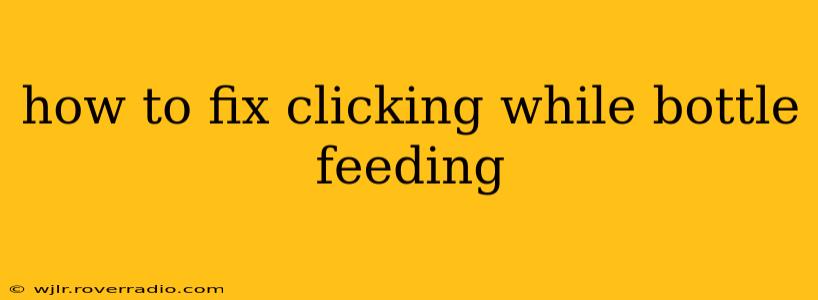Bottle-feeding your baby should be a bonding experience, not a frustrating one. Many parents experience the annoying, sometimes concerning, sound of clicking during feeding. This clicking often stems from a variety of causes, and understanding these is the first step to resolving the issue. This guide will explore common reasons behind clicking during bottle feeding and offer practical solutions to ensure a smooth and comfortable feeding time for both you and your little one.
Why is My Baby Clicking While Bottle Feeding?
The clicking sound during bottle feeding is often caused by a build-up of air in the bottle nipple or a poor latch. Let's dive into the specifics:
1. Air Bubbles in the Nipple:
This is the most common culprit. Air trapped within the nipple can create a clicking or popping sound as your baby feeds. This isn't always harmful, but it can interrupt feeding flow and make it difficult for your baby to get a consistent stream of milk.
2. Incorrect Nipple Flow Rate:
If the nipple hole is too small, your baby might suck harder, creating a vacuum and leading to clicking. Conversely, a nipple with too large a hole can cause gulping and choking, which can also manifest as clicking due to the baby struggling with the fast flow. Finding the right flow rate for your baby's age and developmental stage is crucial.
3. Poor Nipple Shape or Size:
Some nipples are simply not designed for your baby's mouth. A nipple that's too wide, too narrow, or has an odd shape can lead to an improper latch and result in clicking. Experimenting with different brands and shapes might be necessary to find the right fit.
4. Improper Bottle Handling:
Tilting the bottle incorrectly can introduce air bubbles into the nipple, leading to clicking. Make sure the nipple is always filled with milk and that air doesn't get trapped inside.
5. Baby's Latch:
A poor latch can cause a clicking sound. If your baby isn't properly positioned on the nipple, they may be struggling to create a consistent suction, leading to clicking and possibly frustration.
How to Prevent and Fix Clicking During Bottle Feeding
Now that we've identified the potential causes, let's address how to fix them:
1. Check for Air Bubbles:
Before each feeding, carefully inspect the nipple for air bubbles. Gently squeeze the nipple to release any trapped air. You can also try running warm water over the nipple to help any trapped bubbles rise to the surface.
2. Choose the Right Nipple Flow Rate:
Always select a nipple with the appropriate flow rate for your baby's age. Most brands clearly indicate this on the packaging. If you're unsure, consult your pediatrician or a lactation consultant.
3. Experiment with Different Nipple Brands and Shapes:
If clicking persists, try different brands and shapes of nipples. Each brand has its own unique design, and what works for one baby may not work for another.
4. Proper Bottle Handling:
Keep the bottle tilted at the correct angle—enough to ensure the nipple remains filled with milk but not so much that it introduces excess air.
5. Ensure a Proper Latch:
Hold your baby close, ensuring their mouth is properly positioned over the nipple. Observe your baby's feeding; if they seem to be struggling or making clicking noises, reposition them.
6. Consider a Different Bottle Type:
Some bottles are designed to minimize air intake. Experimenting with anti-colic bottles can potentially eliminate clicking.
7. Talk to Your Doctor or Lactation Consultant:
If clicking persists despite trying these solutions, consult your pediatrician or a lactation consultant. They can assess your baby's feeding technique and identify any underlying issues.
Frequently Asked Questions (FAQ)
Is clicking during bottle feeding harmful?
While clicking isn't inherently harmful, it can be a sign of an underlying issue that could affect your baby's feeding efficiency and potentially lead to discomfort or frustration.
My baby clicks even with a new nipple. What should I do?
If clicking persists even after replacing the nipple, try different brands and flow rates. If the issue continues, consult your pediatrician or a lactation consultant.
How do I know if the nipple flow rate is correct?
The milk should flow steadily but not too quickly. Your baby should be able to feed comfortably without choking or gulping. Look for signs of contentment – a relaxed demeanor, a steady feeding pace, and satiety after feeding.
Remember, every baby is different. What works for one may not work for another. Patience and perseverance are key in finding the right combination of bottle, nipple, and feeding technique to ensure a happy and successful feeding experience for both you and your baby.
